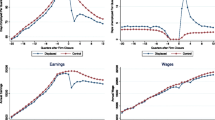Abstract
Within the framework of Markov chains we study the joint impact of fertility and unemployment on the level of Riester annuities in the German market. Using raw data of the Federal Statistical Office and the National Employment Agency, we allow for dependencies between the two risk factors. For predefined scenarios we calculate the expected value and the standard deviation of the Riester annuities. We thereby aim at enhancing individual advice of policy holders focusing on customer needs.



Similar content being viewed by others
Notes
The Federal Statistical Office collects the numbers of live births by birth order and age of the mother no earlier than 2009; the statistics for 2011 are still not published at calculation date.
For women between 60 and 64 we observe a quota of 0.35 % whereas the quota for the age between 55 and 59 is 2.9 %.
The data are extracted from the German employment agency [1], where the period of long-term unemployment is defined as 2 years or more.
For the age of 25, which, in any case, is smaller than the average age at birth of the last child, the age of the youngest child is arbitrarily fixed at 2.
We use Table 3 and \(E\left( R|S_1\right) =58.57\).
References
Arbeit B für (ed) (2003) Arbeitsmarkt in Zahlen: Strukturanalyse–Bestand an Langzeitarbeitslosen. http://www.pub.arbeitsagentur.de/hst/services/statistik/200312/iiia4/st4-langd.pdf. Accessed 8 March 2015
Biagini F, Groll A, Widenmann J (2013) Intensity-based premium evalution for unemployment insurance products. Insur Math Econ 53(1):302–316
Dickson DCM, Hardy MR, Waters HR (2013) Actuarial mathematics for life contingent risks, 2nd edn. Cambridge University Press, Cambridge
Gesamtverband der deutschen Versicherungswirtschaft (2012) Verhaltenskodex Vertrieb. http://www.gdv.de/2015/04/verhaltenskodex-fuer-den-vertrieb. Accessed 3 August 2015
Haberman S, Pitacco E (1999) Actuarial models for disability insurance. Chapman & Hall, Coca Raton London
Henriksen L, Nielsen J, Steffensen M, Svensson C (2014) Markov chain modeling of policyholder behavior in life insurance and pension. Eur Actuar J 4(1):1–29
Feichtinger G (1973) Bevölkerungsstatistik. De Gruyter, Berlin
Hoem JM (1969) Markov chain models in life insurance. Blätter DGVM 9:91–107
Hoem JM (1970) Probabilistic fertility models of the life table type. Theor Popul Biol 1:12–38
Keyfitz N (1971) On the momentum of population growth. Demography 8:71–80
Keyfitz N, Caswell H (2005) Applied mathematical demography, 3rd edn. Springer, New York
Koller M (2012) Stochastic models in life insurance. Springer, Berlin Heidelberg
Mackenroth G (1953) Bevölkerungslehre: Theorie, Soziologie und Statistik der Bevölkerung. Springer, Berlin Heidelberg
Smith DL, Keyfitz N (2013) Mathematical demography. Springer, Heidelberg
Statistisches Bundesamt (2012) Bevölkerung: Deutschland, Stichtag, Altersjahre, Geschlecht. Tabelle 12411-0006. http://destatis.de/genesis/online. Accessed 8 March 2015
Statistisches Bundesamt (2011) Tabellenanhang (erweitert): Neue Daten zur Kinderlosigkeit in Deutschland (XLS). Ergebnisse des Mikrozensus 2008. Tabellen Geburten und Kinderlosigkeit. http://destatis.de/DE/ZahlenFakten/GesellschaftStaat/Bevoelkerung/Geburten/Geburten. Accessed 8 March 2015
Statistisches Bundesamt (2012) Durchschnittliches Alter der Mutter bei der Geburt: Deutschland, Jahre, Lebendgeburtenfolge, Jahr 2010. Tabelle 12612-0012. http://destatis.de/genesis/online. Accessed 8 March 2015
Statistisches Bundesamt (2012) Vier bis fünf Jahre beträgt aktuell der Abstand von Geschwistern. Pressemitteilung Nr. 005. http://destatis.de/DE/PresseService/Presse/Pressemitteilungen/2012/01/PD12_005_12641. Accessed 8 March 2015
Wagner F (2011) Gabler Versicherungslexikon. Springer, Wiesbaden
Zhao Z, Guo B (2012) An algorithm for determination of age-specific fertility rate from initial age structure and total population. J Syst Sci Complex 25:833–844
Author information
Authors and Affiliations
Corresponding author
Rights and permissions
About this article
Cite this article
Steil, S., Kobus, D. & Wolf, J. The joint impact of fertility and unemployment on the level of state-aided pensions. Eur. Actuar. J. 6, 97–111 (2016). https://doi.org/10.1007/s13385-015-0120-9
Received:
Revised:
Accepted:
Published:
Issue Date:
DOI: https://doi.org/10.1007/s13385-015-0120-9




